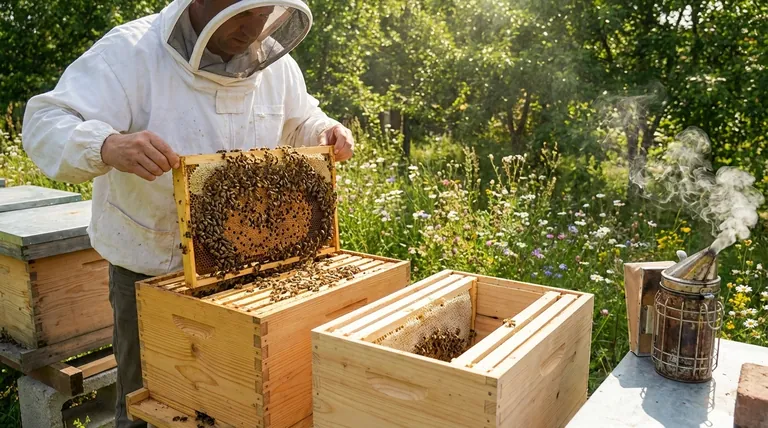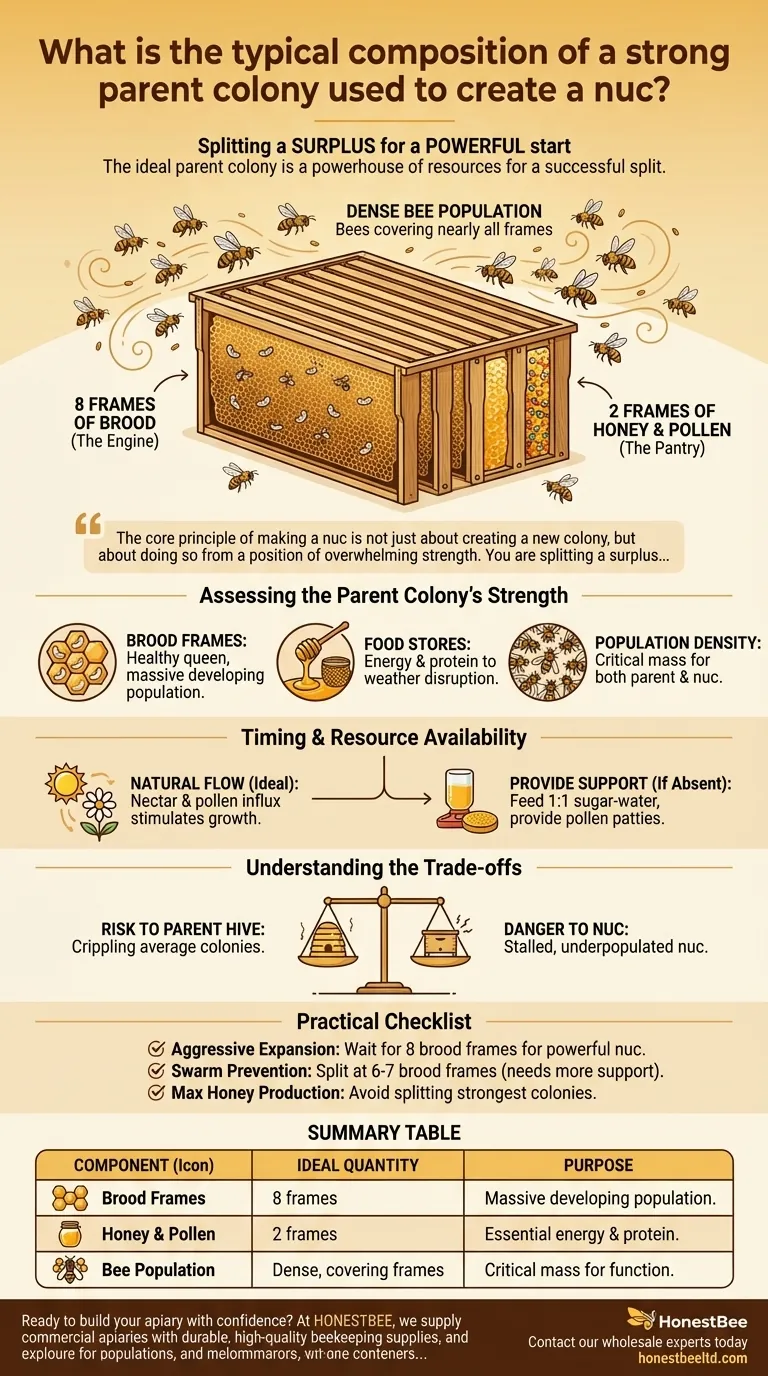For a successful split, the ideal parent colony is a powerhouse of resources, typically containing eight frames of brood and two frames of honey and pollen in a standard ten-frame brood chamber. This robust composition ensures that both the parent hive and the new nucleus colony (nuc) have the population and provisions necessary to thrive.
The core principle of making a nuc is not just about creating a new colony, but about doing so from a position of overwhelming strength. You are splitting a surplus, ensuring the parent hive barely notices the loss and the new nuc has everything it needs for a powerful start.

Assessing the Parent Colony's Strength
Before you can divide a colony, you must verify it has an abundance of the three critical resources: brood, bees, and food. An imbalance in any of these areas can jeopardize the success of the split.
The Significance of Brood Frames
The eight frames of brood are the engine of the hive. This high number indicates a healthy, productive queen and a massive population of developing bees.
This ensures there are more than enough nurse bees to care for young in both hives and a continuous supply of new foragers to gather resources.
The Role of Food Stores
The two frames of honey and pollen act as the hive's pantry. Honey provides the energy for all hive activities, while pollen is the essential protein source for raising new brood.
Having these stores ensures the parent colony can weather the temporary disruption of the split without experiencing a nutritional deficit.
Verifying Population Density
A strong colony isn't just about what's in the frames; it's about the bees covering them. The colony should be bustling with activity, with bees covering nearly all ten frames in the brood box.
This density is crucial because when you pull frames for the nuc, you are also taking the bees that are currently on them. A dense population ensures the parent hive remains strong and the nuc has a critical mass of bees to function.
Timing and Resource Availability
A strong hive in a barren landscape is still at risk. The timing of your split is just as important as the condition of the colony.
The Importance of a Natural Flow
Ideally, you should create a nuc when there is a strong natural nectar and pollen flow. This influx of outside resources stimulates growth and encourages the queen to lay.
When resources are abundant, the bees are naturally inclined to expand, making the split a more seamless process for both colonies.
When to Provide Support
If a natural flow is absent, you must simulate one. Feeding the colony a 1:1 sugar-water mixture can mimic a nectar flow.
Additionally, providing pollen patties can supplement protein needs. This support encourages the colony to build up and prepares it for a successful division, even in suboptimal conditions.
Understanding the Trade-offs of a Split
Splitting a colony is a powerful management tool, but it's not without risks. Making a split from a colony that isn't truly ready can have negative consequences.
The Risk of Crippling the Parent Hive
Taking brood and bees from a colony that is merely average—not booming—can set it back significantly. This can weaken its ability to defend itself, gather a honey surplus, or build up for winter.
The goal is to relieve population pressure, not to create two weak colonies from one mediocre one.
The Danger of a Stalled Nuc
A new nuc requires specific components to succeed. You will typically take one frame with fresh eggs (to allow the nuc to raise a new queen) and one frame of capped brood (to provide an immediate population boost).
If the parent colony doesn't have a surplus of these resources, the nuc you create will be underpopulated and may struggle to build up, defend itself, or survive.
A Practical Checklist Before You Split
Use your primary objective to guide your decision on when and how to make a split.
- If your primary focus is aggressive hive expansion: Wait for the textbook "eight frames of brood" to ensure you are creating a powerful nuc that can grow quickly without slowing down the parent.
- If your primary focus is swarm prevention: You can split a slightly less powerful colony (e.g., 6-7 frames of brood) to relieve hive congestion, but accept that the new nuc may require more time and support.
- If your primary focus is maximum honey production: Avoid splitting your strongest colonies altogether, as this will divide your foraging workforce and likely reduce your honey surplus for the season.
Ultimately, successful beekeeping is about creating new resources from a clear and undeniable abundance.
Summary Table:
| Key Component | Ideal Quantity | Purpose |
|---|---|---|
| Brood Frames | 8 frames | Ensures a massive population of developing bees and a productive queen. |
| Honey & Pollen Frames | 2 frames | Provides essential energy and protein for both hives post-split. |
| Bee Population | Dense, covering frames | Guarantees both parent hive and nuc have a critical mass of bees to function. |
Ready to build your apiary with confidence?
Creating strong splits starts with having the right equipment. At HONESTBEE, we supply commercial apiaries and distributors with the durable, high-quality beekeeping supplies needed to manage powerhouse colonies and ensure successful splits.
Let us equip you for success. Contact our wholesale experts today to discuss your apiary's needs.
Visual Guide

Related Products
- 5 Frame Wooden Nuc Box for Beekeeping
- Twin Queen Styrofoam Honey Bee Nucs Mating and Breeding Box
- Automatic Heat Preservation 6 Frame Pro Nuc Box for Honey Bee Queen Mating
- Plastic Transporting Bee Packages and Nuc Boxes for Beekeeping
- Styrofoam Mini Mating Nuc Box with Frames Feeder Styrofoam Bee Hives 3 Frame Nuc Box
People Also Ask
- What are the benefits of starting a new bee colony in a nuc box? Boost Colony Success with Efficient Beekeeping
- What are the benefits of moving nuclei around the apiary? Master Strategic Hive Management
- How should the nuc be installed in the apiary? Ensure Colony Success from Day One
- What frames should be moved into the queenless hive when requeening with a nuc? Ensure a Successful Queen Introduction
- What is a common feature of many 5-frame nuc boxes? The Integrated Feeder for Efficient Colony Growth



















